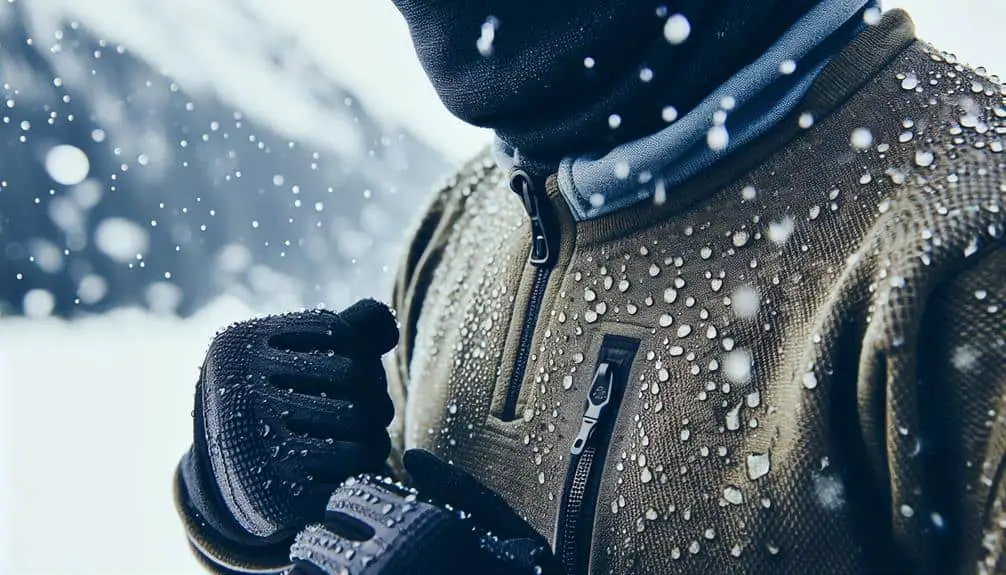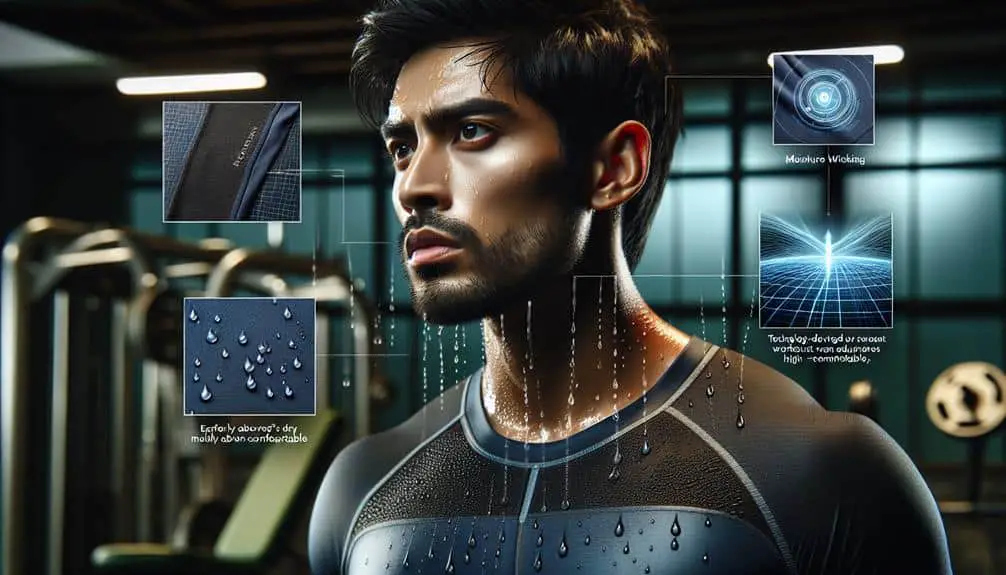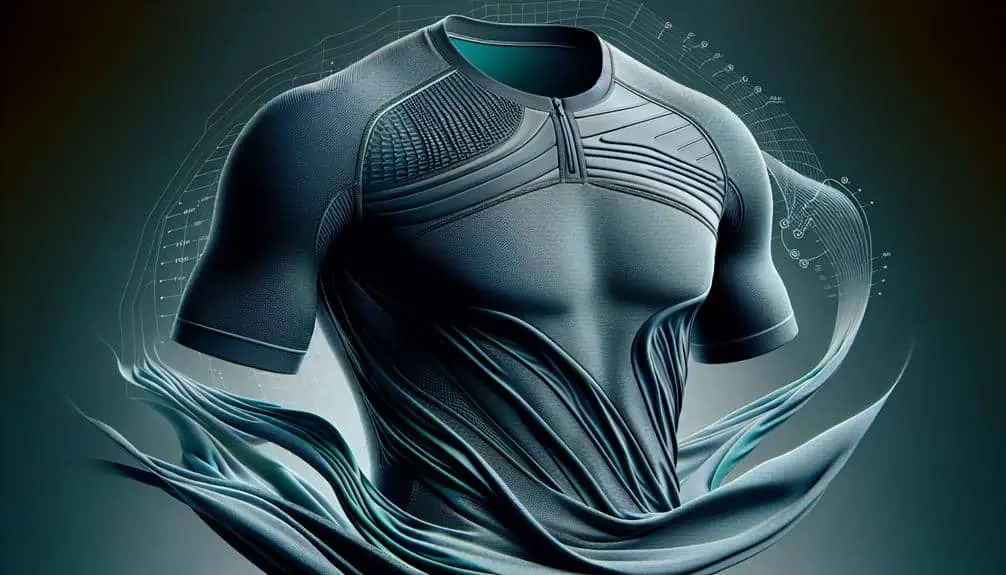Optimize your cold weather performance with moisture-wicking technology. Manage sweat efficiently, regulate body temperature, and reduce heat loss for enhanced comfort during intense cold weather activities. Discover how moisture-wicking fabrics excel in sweat management, odor control, and insulation properties. Choose the right fabric weight to balance moisture management and insulation, from lightweight for intense workouts to heavyweight for extreme cold. Master layering techniques with a moisture-wicking base, insulating mid-layer, and protective outer layer. Maintain your moisture-wicking shirts for peak performance with proper care. Uncover the essential tips for maximizing the benefits of moisture-wicking technology.
Key Points
- Prioritize moisture-wicking fabrics for peak cold weather performance.
- Moisture wicking traps sweat, transfers moisture, and maintains body heat.
- Choose fabric weight wisely for efficient moisture management and insulation.
- Layering with moisture-wicking base, insulating mid-layer, and protective outer layer.
- Maintain moisture-wicking shirts by following care instructions for longevity and performance.
Benefits of Moisture-Wicking Fabrics
When choosing activewear, prioritize moisture-wicking fabrics for peak performance in cold weather. These fabrics excel in sweat management, pulling moisture away from your skin to the outer surface of the garment where it can evaporate quickly. This process helps regulate your body temperature by keeping you dry and preventing the vital effect of wet clothing against your skin.
Additionally, moisture-wicking fabrics play an essential role in odor control. By reducing the amount of sweat that stays on your skin, they minimize the growth of odor-causing bacteria, keeping you fresh during and after intense workouts. This dual-action of moisture management and odor control not only enhances your comfort but also allows you to focus on your performance without distractions.
When selecting your cold-weather activewear, opt for garments made from advanced moisture-wicking materials to experience the benefits of staying dry, warm, and odor-free throughout your training sessions.
How Moisture Wicking Keeps You Warm
Moisture-wicking technology in cold-weather activewear works by trapping sweat and transferring it away from your skin, helping to maintain your body heat and keep you warm during outdoor activities. When you engage in physical exertion in cold weather, your body generates heat. Sweat is a natural byproduct of this process, but if it remains on your skin, it can lead to discomfort and chill. Moisture-wicking fabrics excel at thermal regulation by swiftly moving moisture to the outer surface of the fabric where it can evaporate, preventing it from cooling against your skin.
Furthermore, the insulation properties of moisture-wicking materials play a vital role in keeping you warm. By effectively managing moisture, these fabrics help create a dry microclimate next to your skin. This dry environment enhances the insulation provided by your clothing layers, reducing heat loss and reinforcing your body's natural warmth. The combination of efficient moisture transport and enhanced insulation makes moisture-wicking technology an essential component in maintaining the best body temperature and comfort during cold-weather pursuits.
Choosing the Right Fabric Weight
For essential performance in cold weather, selecting the ideal fabric weight is crucial to guarantee efficient moisture management and insulation. Fabric selection plays a vital role in determining how well your clothing can regulate moisture and provide insulation.
When choosing fabric weight, consider the insulation properties needed for the specific cold weather conditions you'll encounter. Lightweight fabrics are ideal for high-intensity activities where breathability is key, allowing moisture to be wicked away from the body.
Medium-weight fabrics strike a balance between insulation and breathability, suitable for moderate cold temperatures. Heavyweight fabrics offer maximum insulation, perfect for extremely cold conditions but may sacrifice some breathability.
Understanding the insulation properties of different fabric weights is vital in ensuring that you stay warm and dry in cold weather. Prioritize fabric that effectively manages moisture while providing the necessary level of insulation to keep you comfortable during your cold weather activities.
Layering Techniques for Cold Weather
Effective layering techniques in cold weather require strategic consideration of garment combinations to optimize insulation and moisture management for comfort and performance.
Insulation strategies are vital in maintaining warmth. Start with a moisture-wicking base layer to manage sweat and keep your skin dry. The mid-layer should focus on trapping heat; materials like fleece or down are excellent choices. Guarantee proper fit to minimize air gaps that can cause heat loss.
Your outer layer acts as a shield against wind, rain, and snow. Choose a waterproof and breathable material to prevent moisture from seeping in while allowing sweat to escape. Remember, layering is about creating a system that works together to regulate your body temperature.
Avoid cotton as it retains moisture, leading to discomfort and increased heat loss. By mastering the art of layering with the right materials and proper fit, you can stay warm, dry, and comfortable in the coldest of conditions.
Maintenance Tips for Moisture-Wicking Shirts
To maintain peak performance and longevity of moisture-wicking shirts, diligently follow recommended care instructions provided by the manufacturer.
Washing methods are essential for maintaining the effectiveness of moisture-wicking shirts. Always wash them in cold water on a gentle cycle to prevent damage to the fabric's moisture-wicking properties. Use a mild detergent that's free of fabric softeners and bleach, as these can clog the fabric and reduce its moisture-wicking capabilities. Turn the shirts inside out before washing to protect the outer surface and the shirt's design.
When it comes to drying techniques, avoid using high heat as it can damage the fabric and reduce its moisture-wicking abilities. Instead, opt for air-drying or tumble dry on low heat. Remove the shirts promptly from the dryer to prevent wrinkles and potential damage from over-drying. Hanging moisture-wicking shirts to dry is also a suitable method that helps maintain their shape and performance.
Frequently Asked Questions
Can Moisture-Wicking Technology Be Used in All Types of Clothing, or Is It Mainly for Activewear?
Moisture-wicking technology isn't just for activewear; it can enhance everyday clothing too. The benefits go beyond sweat management, offering comfort and versatility. Approximately 85% of people find moisture-wicking fabrics more comfortable in daily wear.
Is Moisture-Wicking Fabric Suitable for Extreme Cold Weather Conditions, Such as Sub-Zero Temperatures?
Layering techniques are essential for extreme cold. Moisture-wicking fabric helps manage sweat, but alone may not suffice. Pair it with proper insulation for sub-zero conditions. Guarantee breathable warmth when engaging in outdoor activities.
Are There Any Specific Care Instructions for Washing and Drying Clothing With Moisture-Wicking Technology?
To maintain clothing with moisture-wicking technology, always follow care instructions. Wash in cold water, avoid fabric softeners, and tumble dry on low heat. Proper storage guarantees longevity. Choose eco-friendly detergents for sustainability. Remember: Care = Durability.
Can Moisture-Wicking Technology Help Prevent Odors From Sweat During Physical Activity in Cold Weather?
In cold weather, moisture-wicking technology excels at managing sweat to prevent odors during physical activity. This performance benefit enhances layering options by keeping you dry and comfortable, maintaining ideal body temperature for peak performance.
Are There Any Specific Brands or Types of Moisture-Wicking Fabric That Are Known for Providing Exceptional Cold Weather Performance?
Looking to excel in cold weather activities? Wondering about the best brands for moisture-wicking fabric? Discover the top performers for cold weather. Stay ahead with cutting-edge technology designed for peak performance in chilly conditions.



